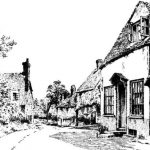This week at The Archive has been another incredibly busy one, as we have added 116,740 brand new pages, with eight brand new titles in all joining us. And all of our eight new titles of the week hail from Wales, and include two Welsh language newspapers, a specialist political title, and a shipping gazette. Meanwhile, we have updated 26 of our existing titles.
So read on to discover more about our eight brand new titles of the week, as well as to find out which newspapers we have updated over the past seven days, and to learn more about the first ever woman M.P. to represent a Welsh constituency, Megan Lloyd George.
Register now and explore the Archive
Kicking us off this week is the lively local newspaper the Caerphilly Journal. Published every Thursday in the town of Caerphilly, north of Cardiff, the Caerphilly Journal spanned eight pages and cost one penny, with a particular focus on local news. For example, within the pages of this newspaper, you could find the latest from the Caerphilly Petty Sessions, the Caerphilly District Council, the Caerphilly Secondary School and the Rhondda Urban District Council.

Meanwhile, the Caerphilly Journal did not shy away from covering the gossip from the local area, listing ‘chestnuts’ from the locality, such as this one from the early 1920s:
Who are the local lady-killers that parade the streets? Gold-coloured socks etc. Swank, what oh!
With a focus on sport, covering the Rhondda Valleys Cricket League, bowls and even baseball, the Caerphilly Journal also featured ‘Financial News,’ updates from the area’s chapels, and notices of marriages and deaths.
We stay in the Rhondda Valleys for our next new title, which is the Rhondda Socialist Newspaper. Boldly claiming to be the ‘BOMB of the Rhondda Workers,’ the Rhondda Socialist Newspaper was first published on 19 August 1911 in Pontypridd.

Initially following a monthly publication pattern, the Rhondda Socialist Newspaper addressed ‘the Workers of the Rhondda Valleys,’ and cost just one halfpenny. With features like ‘Industrial Notes’ and a ‘Literary Column,’ this publication contained news from the local area, as well as columns written in the Welsh Language. It also contained advertisements for ‘Great Socialist Meetings,’ such as one that was set to be addressed by Marion Phillips and Annot E. Robinson, from the Women’s Freedom League.
On 24 May 1913 the Rhondda Socialist Newspaper changed its name to the South Wales Worker, and publication of the newspaper became fortnightly. With this change to its title, the South Wales Worker had a broader remit, with less of a focus on local news. Indeed, it featured international updates, including an ‘International News Letter’ and a look at the ‘Employment of Children in German Glass Factories.’

The South Wales Worker also contained more scholarly articles on socialist themes, with looks at possible objections to socialism, as well as articles like ‘How the Collier is Robbed.’ It also included correspondence and editorial notes, surveys of the unions and how they should be coordinated. This formula seemed to be a successful one; the newspaper claimed to have a circulation that was ’30 times greater than that of any paper printed in the Rhondda Valley.’
Another of our specialist new titles this week is the Cardiff Shipping and Mercantile Gazette, which was founded in 1859. Covering the business conducted at Cardiff’s ‘extensive docks,’ this publication appeared every Monday, and cost 21 shillings for a yearly subscription. It was also politically neutral, and contained:
…a complete record of the Shipping Business of Cardiff, Swansea, Newport, and the Bristol Channel, circulating amongst all the Merchants and Brokers of the Bristol Channel Ports, and generally throughout the various ports of the United Kingdom. It is filed at Lloyd’s and most of the Chambers of Commerce, and is also sent to the leading Foreign Ports.

And it is to Newport that we go for our next new title of the week, which is the Newport Gazette. Established in 1857, the Newport Gazette was published in the city of Newport, which lies to the north east of Cardiff. Costing three halfpence, the Newport Gazette was a Liberal newspaper which spanned eight pages, and also positioned itself as a ‘General Record for Pontypool, Blaenavon, Tredegar, Risca and Caerleon.’
Containing local news from Newport Town Council, as well as police intelligence from the County and Borough Police, the Newport Gazette also covered the ‘District Intelligence’ from the likes of Pontypool and Risca, and the latest from the ‘Chamber of Agricultural for Monmouthshire.’ Meanwhile, it was international in its outlook, with reports on the health of Count Bismarck, whilst also featuring news from across the United Kingdom, including the latest from parliament.

Finally, the Newport Gazette featured poetry, shipping and commercial news, ‘Metropolitan Gossip,’ railway timetables, and notices of deaths in the local area. The Newport Gazette eventually became incorporated with the Star of Gwent.
Our next two new titles both hail from Porthcawl, a town near Bridgend and an important nineteenth century coal port. The first of these two titles is the lively Porthcawl News, which was first published on 12 May 1910 at the cost of one penny, and embraced ‘Newton Nottage, Kenfig Hill and Pyle.’
With its first page given over to adverts, the Porthcawl News looked at the biggest news of the day, for example covering the return of Doctor Crippen to Britain. With a focus on interesting national news stories, with headlines including ‘Brighton Bullock Case,’ a ‘Street Tragedy at Oldham,’ and ‘A Lady Bather Rescued,’ the Porthcawl News also featured illustrated cartoons. Meanwhile, the newspaper looked at local news, featuring the latest from the Porthcawl District Council, as well as ‘Reflections from Porthcawl,’ a ‘Porthcawl Paragraph,’ and a tide timetable for the town.

Nothing if not lively, the Porthcawl News covered sport, reporting on cricket and golf, as well as featuring a fashion column called ‘Dress of the Day,’ with illustrations of the latest fashions. Meanwhile, the newspaper devoted some of its space to the lighter side of life, with a ‘Humour of the Week’ column, as well as featuring poetry and short stories. Finally, the newspaper also contained a list of visitors to the town, as well as advice on ‘Where To Go in Porthcawl.’
Our second new Porthcawl title of the week is the Porthcawl Guardian, a sister paper to the Neath and Port Talbot Guardians. Appearing every Friday, by the 1950s the paper consisted of sixteen pages and cost three pence, with a focus on local news, featuring notices of births, engagements, deaths and anniversaries. With a raft of local interest stories, the Porthcawl Guardian had a particular focus on cinema, containing columns called ‘Cinema Chat’ and ‘Spotlight on Next Week’s Films,’ as well as featuring ‘Sporting Chatter,’ with reports on football, cricket and darts.
Our two final new titles of the week are both Welsh language titles, and we are incredibly excited to welcome them to The Archive. First up is Herald Cymraeg, or the ‘Welsh Herald,’ a Liberal title which was founded in 1854. Appearing every Tuesday, Herald Cymraeg was published in Caernarvon, in North Wales, and contained ‘general news of and for the Welsh people, but with a special focus on literature.’

Indeed, one famous editor of the Herald Cymraeg was Robert John Rowlands, who is perhaps better known by his bard name of Meuryn. Rowlands was a Welsh poet, novelist and children’s author, who is viewed by many as a pioneer of Welsh children’s literature, and he edited Herald Cymraeg between 1921 and 1954. Indeed, many famous Welsh writers contributed to the newspaper, including T. Gwynn Jones, Edward Prosser Rhys and Gwilym R. Jones.
In 1937 Herald Cymraeg merged with Genedl Cymreig to from Herald Cymraeg a’r genedi, and it still continues to be published to this day, having appeared since 2004 as an appendix every Wednesday to the Daily Post.
Our final new title of the week is Y Gwyliedydd, or ‘The Watcher,’ a Liberal newspaper which was established in 1877. Appearing every Wednesday, Y Gwyliedydd was the ‘Organ of the Welsh Wesleyans,’ and was published from 13 Sussex Street, Rhyl. Printed in Welsh, Y Gwyliedydd contained ‘the local and district news,’ and circulated in ‘Rhyl and the district of North Wales,’ whilst also having a presence in the ‘main cities of England.’

One of the founders of Y Gwyliedydd was William Hugh Evans (1831-1909), who edited the paper for thirteen years. Y Gwyliedydd cost one penny, and described itself as a ‘Journal and Weekly Reviewer.’
That’s it for our updated titles of the week. Meanwhile, you can find a full list of all the pages we have added to our existing titles at the end of this blog.
The First WOman M.P. for a Welsh Constituency – Megan Lloyd George
In May 1929, the youngest daughter of former Prime Minister David Lloyd George, Megan Lloyd George, was elected as Liberal M.P. for Anglesey, making her Wales’s first woman M.P.

And two years before, Megan Lloyd George caused some excitement in Caerphilly, when she was passing through the town en route to Llantwit Fardre, where she was to open a Liberal fete. Our new title the Caerphilly Journal report how she was:
…warmly greeted by members of the Caerphilly Liberal Association, and a bouquet was presented to her by Mair Tailiesin (Mrs. Joseph Morgan) who was dressed in national costume. Miss George thanked the people of Caerphilly for their warm welcome, and said she would take an early opportunity to visit the town and its historical estate.
Fast forward two years, and there was a buzz even in the south of Wales at the prospect of a woman representing one of the constituencies in the principality of Wales, evident at the Women’s Liberal Conference at Caerphilly, which the Caerphilly Journal reported on in January 1929.

At an ‘enthusiastic gathering’ of the organisation, Mrs Dapho Powell addressed attendees, expressing her pride of both Grace Roberts, a prospective Liberal candidate for Caerphilly, and of Megan Lloyd George.
Mrs Dapho Powell went on to tell the conference that:
She wanted to impress upon them that they were citizens of no mean city and members of no mean party. They should put their backs into the fight. It was a good sign to see women taking a responsible part in politics. Men like a little excitement in their politics with the result that women had to do the spade work for an election. From now to the general election, every woman should see that they were going to do something for Liberalism and then would see what strides would be made.

And strides were to be made – Megan Lloyd George was returned as Liberal M.P. for Anglesey at the 30 May election, with a majority of 5,618, making her one of fourteen women M.P.s elected that year. With her father David Lloyd George also re-elected, they became the first father and daughter to sit in the House of Commons together.

New Titles
| Title | Years Added |
| Caerphilly Journal | 1914-1943 |
| Herald Cymraeg | 1858-1900, 1902, 1904-1911, 1913-1916 |
| Porthcawl Guardian | 1933-1961 |
| Porthcawl News | 1910, 1912-1925 |
| Newport Gazette | 1857-1869, 1891 |
| Cardiff Shipping and Mercantile Gazette | 1875-1881, 1883-1886, 1888-1889 |
| Y Gwyliedydd | 1877-1883, 1885-1887, 1889 |
| Rhondda Socialist Newspaper | 1911-1914 |
This week we have updated 26 of our existing titles.Updated Titles
| Title | Years Added |
| Atherstone News and Herald | 1911-1912, 1950 |
| Saffron Walden Weekly News | 1985, 1993 |
| Hull Daily News | 1879, 1896-1899 |
| Coleshill Chronicle | 1874 |
| Fleetwood Chronicle | 1845 |
| Press (London) | 1860 |
| Sun & Central Press | 1871 |
| Grantham Journal | 1971, 1998-1999 |
| Herts and Essex Observer | 1981 |
| New Milton Advertiser | 1993 |
| London and China Express | 1916-1917, 1921 |
| Fenland Citizen | 1993 |
| Newark Advertiser | 1992 |
| Stamford Mercury | 1954, 1985 |
| Spalding Guardian | 1893-1894, 1903, 1921, 1976 |
| Diss Express | 1993 |
| South Wales Daily Telegram | 1888 |
| Y Tyst | 1893 |
| Newcastle Guardian and Silverdale, Chesterton and Audley Chronicle | 1897 |
| Glamorgan Advertiser | 1950 |
| South Wales Weekly Argus and Monmouthshire Advertiser | 1897 |
| Llanelly and County Guardian and South Wales Advertiser | 1911 |
| Kilmarnock Standard | 1875-1891 |
| Flintshire Observer | 1899, 1912 |
| South Eastern Gazette | 1875 |
| Oxford Chronicle and Reading Gazette | 1872 |
You can learn more about each of the titles we add to every week by clicking on their names. On each paper’s title page, you can read a FREE sample issue, learn more about our current holdings, and our plans for digitisation.
You can keep up to date with all the latest additions by visiting the recently added page. You can even look ahead to see what we’re going to add tomorrow.






